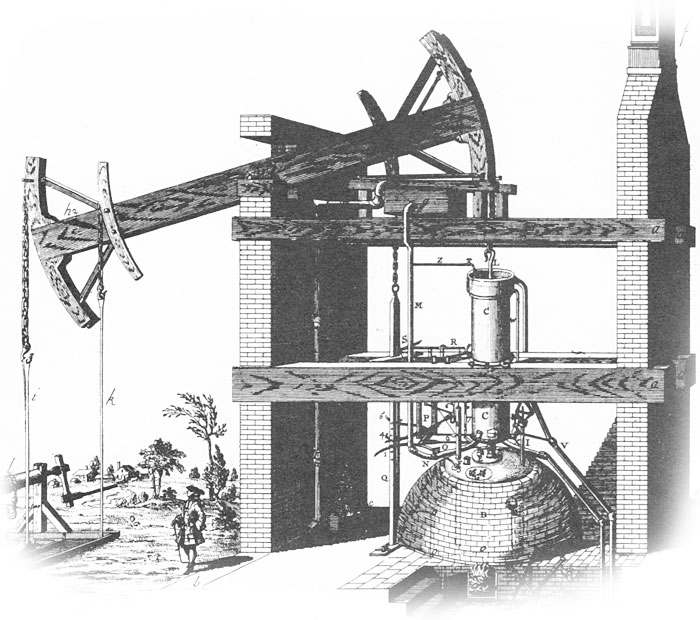
<< Before: The Weight of Air
At the dawn of the 18th century, Thomas Newcomen invented the first useful steam engine , which pumped water out of mines. His machine condensed steam, taking energy from the weight of the air. Its action was based on scientific knowledge obtained by Torricelli, Pascal, von Guericke and others in the previous century. So the science of pressure has come full circle - the questions posed in the creation of mine pumps, after their solution, helped to develop an improved pump. In this story, we will see this interweaving of useful mechanisms and philosophical questions more than once.
However, engineering thought, which went from Torricelli to Newcomen, did not move along straight paths. Injection of hot steam from an external boiler to organize the piston movement was a completely non-obvious way of exploiting the weight of the air. At first, the inventors tried a simpler approach - burning fuel in the piston itself.
Powder machine
In 1661, Otto von Guericke invented the first suction pump, which lifted a load with a piston due to the fact that air was pumped out from under it. It was an excellent demonstration of the weight of air, but it was difficult to call such a device useful - it simply turned one mechanical work (pumping air) into another, while suffering losses.
In that era, it was natural for inventors to turn to gunpowder, the most powerful energy source known to solve the problem of emptying the cylinder. Several kilograms of gunpowder can hurl a cannonball with such force that it breaks through a stone wall, plunges into the oak sides of a ship, or scatters a column of soldiers. If this energy could be tamed and put into smoother operation, it would provide a new alternative to water and windmills. And Christian Huygens , as the most ardent advocate of the powder machine, believed that much more could be achieved with the help of gunpowder.
Huygens spent most of his life in The Hague, and became a member of the Royal Society, located across the English Channel, in England. However, in 1666 he was lured to Paris, offering him a position at the French Academy of Sciences. Unlike the English institution, which was simply a private community of gentlemen hired by the monarch, the French Academy was a public entity organized and funded by the Prime Minister of Louis XIV, Jean-Baptiste Colbert . Huygens proposed his large-scale research program, in which it was supposed to study vacuum, energy of steam and wind, and "the energy of gunpowder, a small portion of which is enclosed in a very thick iron or copper case" [2].
In his 1673 manuscript, he argued that his new car (which at that time existed in the form of a prototype) would revolutionize the use of a mixture, at that time only used for violence:
, , , , , , , , , . , . . , , [3].
Huygens was one of the greatest minds of the seventeenth century. He wrote works on mathematics, optics, mechanics and astronomy, and invented the most accurate chronometer for its time - a pendulum clock. However, the powder machine, for all his fervent assurances, cannot be counted among his greatest successes. It used a piston inside a metal cylinder with two round holes at the top, equipped with something like one-way valves. At the bottom there was another hole for connecting a plate with a powder charge. When the charge was ignited, the piston rose up under the influence of expanding gases, which then escaped through the valves that opened in the upper position of the piston (Huygens used sleeves made of wet leather as valves). Since most of the air escaped from the cylinder,the pressure inside dropped dramatically, and the atmosphere pushed the cylinder back down.
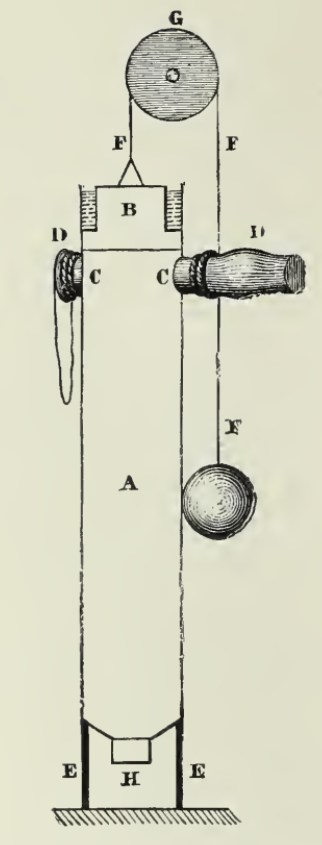
. H , , CD. , .
In addition to the problem of automating the replacement and ignition of powder after each cycle, the machine was simply not efficient enough for any practical use. Gunpowder in England at the end of the 17th century was by no means a cheap source of energy. The cost of two pounds of gunpowder was equal to the average daily wage [4]. However, the biggest problem was that only part of the gases escaped from the cylinder, the air pressed on the piston too weakly, and the system reached equilibrium after several cycles. However, it didn't take long for other inventors to figure out that steam condensation could serve the same purpose with greater efficiency, and for this you can burn any fuel - the cheaper the better.
Steam engine
The fact that steam can move things has been known since antiquity. The philosopher, mathematician and teacher Heron of Alexandria , the last great intellectual to appear in Ptolemaic Egypt before its decline under the yoke of the Roman Empire - the same one that described the fire pump - also described the engine powered by steam. It consisted of a closed kettle with two tubes extending from the lid to opposite points of a hollow metal sphere, made so that it could rotate on the axis of these tubes. Above and below it came out two more tubes, bent at right angles. When the cauldron filled with water began to heat from below, the steam passed into a ball and escaped from the bent tubes, which made the sphere rotate.
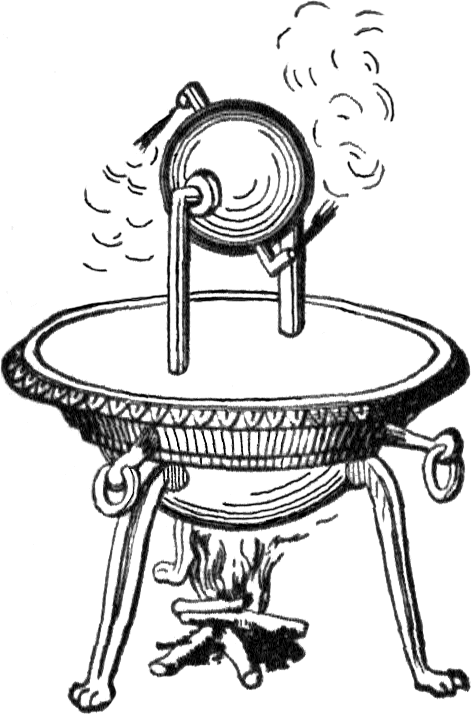
Heron's engine. The water in the boiler turned into steam, passed into a sphere through two pipes, and, breaking out of two bent pipes, made it rotate.
Some call it the first steam engine, but this machine worked on the same principle as many modern lawn sprinklers. Try to make the mill run with a sprinkler, and you will see whether Heron's machine was of practical importance as a steam engine. Heron did not elaborate much on the work of this invention, but, apparently, it served only as entertainment for guests or as an illustration for a philosophical lecture.
More practical was the eolipil, the "Aeolian ball" dedicated to the god of the wind and described by Vitruvius, another great mechanic of the classical world. (sometimes these terms are confused, and the engine of Heron is called eolipil [5]). It was also known as the "breather," and its circuitry was simpler than Geron's ball. It consisted of a metal container with a small opening. When it was filled with water and heated, it gave out a jet of steam. This jet could be used to fan flames instead of bellows, and after the humanists of the Renaissance spread Vitruvius's work, the eolipils gained popularity in Europe. They were made in all sorts of beautiful shapes (often in the form of a human head blowing steam out of the mouth), and they were clearly used as both decorative objects and devices for alchemists and glassblowers.
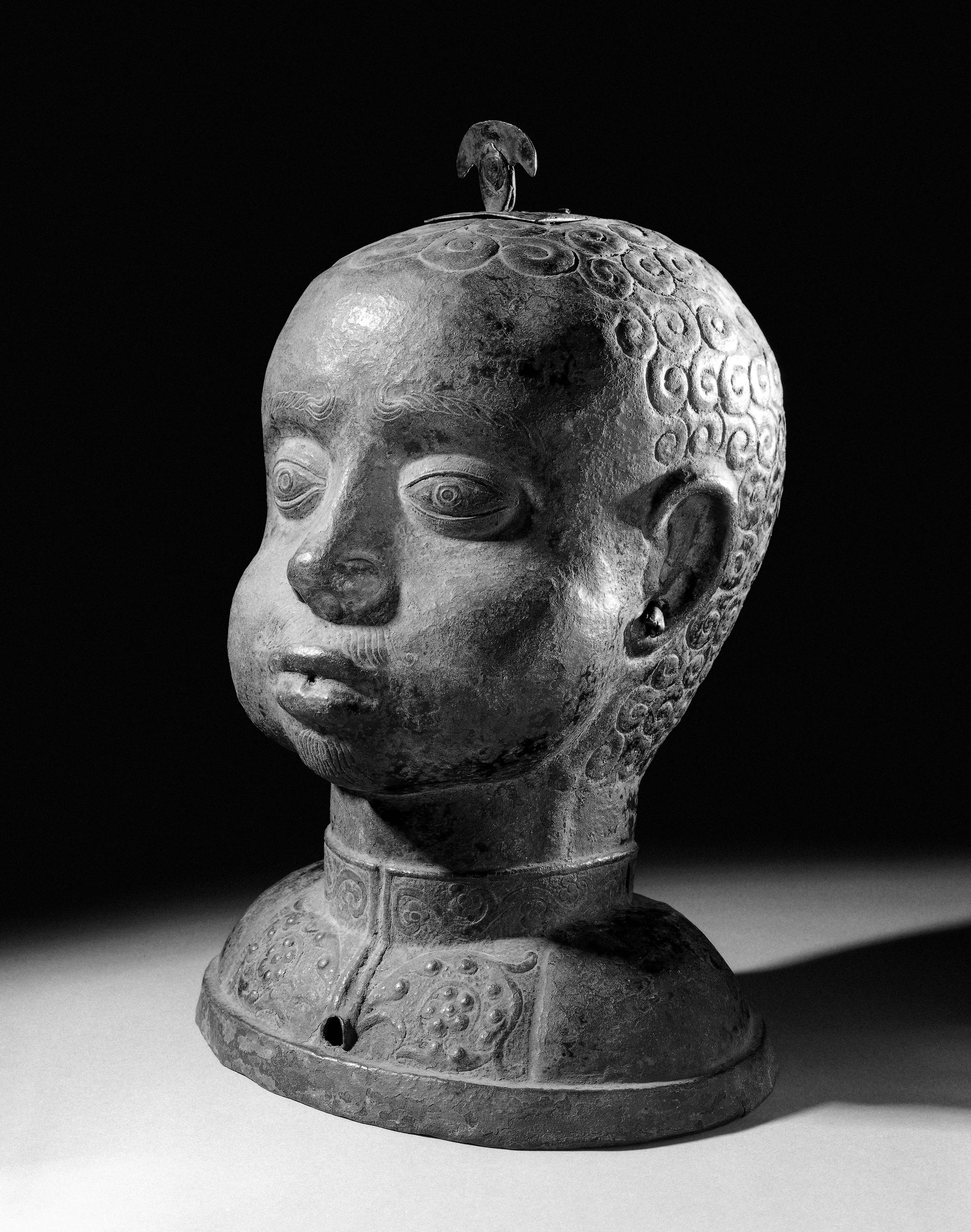
Eolipilus in the form of a human head, from 16th century Italy
Heron's engine and eolipil treated steam like wind, but the new 17th century science of pressure brought new attention to the potential of steam as a substance capable of compressing and expanding volume. In 1683, the English baronet Samuel Moreland wrote a treatise in which he noted that steam occupies a volume 2000 times greater than the same mass of liquid water, and that such steam, “being controlled according to the laws of statics, and by means of science reduced to a measure of weight and balance, peacefully does his job, like good horses, and, therefore, can bring great benefits to mankind, especially in matters of raising water ”[6]. It was in the light of these statements that Huygens' former assistant at the Royal Academy, Denis Papin, many years later, began to rethink his former mentor's gunpowder engine.
Papen, 18 years younger than Huygens, first studied to be a doctor, and then in 1673 became Huygens' assistant. However, he believed that, like a Huguenot , he would not have a chance to unfold in an atmosphere of the Catholic tyranny of the monarchy under Louis XIV. Therefore, in 1675 he emigrated to London, began active work in the Royal Society, for some time he worked as an assistant to the most prominent researcher of air and vacuum in England, Robert Boyle . In 1687, he took a scientific position in the German Marburg in the Landgrave of Hesse-Kassel, where there was a Huguenot refugee diaspora.
The Landgrave wanted Papen's help in creating fountains for his province, and by 1690 Papen had developed for this purpose a model of a steam engine with a cylinder 6 cm in diameter [7]. He began development by trying to improve the powder engine, but he succeeded as little as he and Huygens alone in the 1670s. Apparently, the idea to replace gunpowder with steam came to him thanks to his own invention of the double boiler in 1679 - the ancestor of modern pressure cookers, which already had a safety lever that was lifted by steam [8]. The Papen engine consisted of a cylinder with a little water underneath and a conventional piston. When heated enough, the water turned into steam and pushed the piston upwards. At the top, the piston was held by a latch while the steam cooled and condensed, after which it opened and the air pressure pushed the piston back down.He hoped to use one fire to heat several cylinders connected to a common crankshaft, so that the fire heats one cylinder to the boiling point, and then passes to another, so that the first has time to cool down, and the result would be continuous motion [9].

. , .
However, this engine, like several other inventions made by Papen for the Landgrave - blowing machine, steam boat, steam cannon - never made it out of the prototype stage. Papen felt increasing pressure from his enemies in Marburg. After several important persons were injured in an accident in 1707 with his steam cannon, he decided to leave. After an unpleasant journey, during which the prototype of his steam boat was confiscated and destroyed by boatmen who did not want to part with the privileges of their guild, he reappeared in London. Since his former patron, Boyle, was long dead, Papen sank to poverty and died shortly after January 1712 - the last record of his activities was left that month [10].
In the historical records of that time, there are other traces of thinking about steam engines, but Papen was the first reliably known person who actually built such an engine (albeit only in the form of a prototype), and had a serious sponsor (landgrave). Why did Papen not gain fame and wealth, and died in poverty? Having focused on the example of his double boiler, Papen could not refuse the high-pressure steam that pushed the piston - and this went beyond the capabilities of metallurgy in the 17th century. This is probably why he was unable to scale his engine. Besides, his car was too simple. By heating the water in situ, inside the cylinder, it was tied to a constant cooling and heating cycle that took a lot of time and fuel. However, by the time of his death, two Englishmen, engaged in completely different tasks,surpassed his work, and produced the first practical steam engines.
Newcomen
In 1698, an English military engineer from a Devonshire family of entrepreneurs named Thomas Severipatented his "miner's friend" - the first serious attempt we know of to exploit the fluidity of steam for commercial purposes. However, his creation, strictly speaking, was not an engine at all - it was a pump powered by steam. He filled the chamber with steam from a separate boiler and then poured water outside to condense the steam. The resulting vacuum pulled the water up the pipe. Like any pump, such a thrust was only enough to raise water to a height of about 10 m, so to pump water further to the surface, it relied on the impulse of the next portion of high-pressure steam. As a result, it suffered from the same problems as the injection pump - for the greatest efficiency it had to be installed deep in the mine, and the height of the water rise was limited by the capabilities of the metallurgy of those times. It was necessary to make vessels and pipes,able to withstand the required pressure. Several of his cars are known to have been torn apart at the seams, sometimes with fatal consequences.
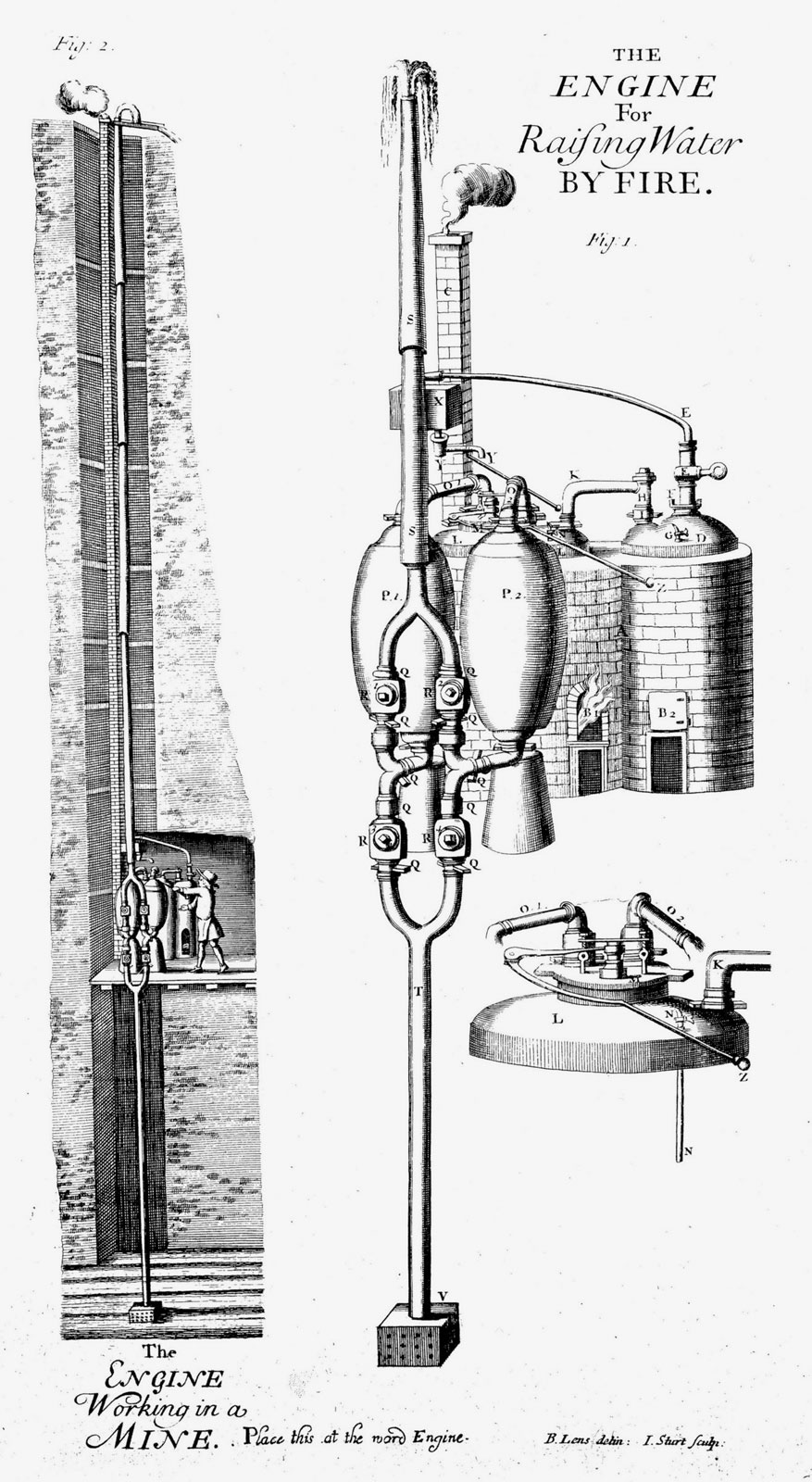
An engraving depicting Severi's machine showing how it could be used in a mine. Note the tall vertical pipe required to bring water to the surface. Egg-shaped tanks were used for continuous pumping - one was filled with high-pressure steam, squeezing water upward, and in the other, steam condensed, sucking the water out from below.
The Severi circuit was used on various occasions as a source of water pressure - for aristocratic gardens, for example - and other inventors continued to improve the pump for several decades. But, despite the nickname Severi gave to his brainchild, the inability of the "miner's friend" to raise water to a considerable height without the risk of an explosion prevented him from becoming a popular equipment for mines.
Meanwhile, another Thomas was working on a different scheme of the steam engine. Thomas Newcomen, like Severi, was from Devonshire, traded in ironmongery and blacksmiths and tools for the mining industry. It is unknown if he was aware of the existence of the Severi steam pump - they certainly had opportunities to cross in Devonshire. In any case, his machine turned out to have a completely different scheme, and in it there was nothing from the Severi, except for the idea of using steam as a working fluid that produces mechanical force. Unfortunately for Newcomen, Severi filed a very general patent granting him exclusive rights to "manufacture, simulate, use and use any reservoir or motor to raise water or possibly rotate mills by the force of fire." Newcomen had to become a partner of Severi and his heirs, regardless of the origin of his ideas [11].

Engraving of Newcomen's car at the Griff Collieri Museum near Coventry. Condensing in the cylinder on the left, the steam pulled down the left side of the rocker arm, forcing the pump on the right. As steam was added, the weight of the rocker lowered its right side. Above the piston, you can see a reservoir for the raised water, and under it - a boiler lined with brick.
Newcomen's fully realized project (built with the help of John Callie, who is sometimes referred to as a glassblower or a tinker in various sources), had two key benefits.
Firstly, he only used steam condensation to move the piston, so he had no problem with high pressure steam tanks. He returned to von Guericke's original concept, turning it inside out. The piston was attached to one end of a heavy wooden rocker arm, to the other end of which a pump was attached. When steam condenses in the cylinder, the air pressed against the piston and lifted the other end of the rocker arm, driving the pump. Injection of fresh low-pressure steam did not raise the piston, but equalized the pressure from above and below, due to which the rocker arm was lifted to its original position under its own weight.
Secondly, steam condensation occurred due to the injection of cold water into the cylinder, due to which the piston stroke was faster and more powerful in comparison with the external cooling of the tank at Severi. Apparently, Newcomen accidentally stumbled upon such a scheme, when water, which was supposed to cool the cylinder from the outside, accidentally leaked inside.
But besides these improvements, Newcomen's invention was a demonstration of a mechanical genius far ahead of all his predecessors. After many years of experimentation, he managed to make his engine fully automatic - all the valves that controlled the inlet and outlet of steam were controlled by pegs on a rotating rod that rotated the engine itself.
Sometimes they write that the equipment that allowed the machine to work autonomously was invented by a boy who was hired for this work. He was supposedly tired and decided to improve it. It is more likely that he just made some slight improvement to an already almost self-contained unit. Unfortunately, no documentation of the time of the development of this machine was found, so this issue is unlikely to be resolved in one direction or another.
The need for a source of cold water to cool the steam was also taken into account. A small auxiliary pump pumped water out of the sump, from where it drained after exiting the cylinder into the tank above the engine. It could then be lowered by gravity and reused.
Wheezing and crackling and wheezing, swaying back and forth again and again until the source of his steam diet dried up, the Newcomen engine was the closest device to an artificial life form invented by man at that time. One poet compared the boiler to a breathing "iron womb" [13]. Another, Erasmus Darwin (Charles's grandfather), compared the machine to a nodding giant:
Cold water streams stop expanding,
And a huge cloud of steam turns into a droplet.
The piston under the air, weighing down to the end, descends
Quickly, because it does not cling to the iron walls anywhere.
The giant man-made
beam swings quickly and deftly, Paul shaking, he waves his hands, and seems to nod.
Bade with cold streams the quick expansion stop,
And sunk the immense of vapor to a drop.
Press'd by the ponderous air the Piston falls
Resistless, sliding through it's iron walls;
Quick moves the balanced beam, of giant-birth,
Wields his large limbs, and nodding shakes the earth. [14]
The exact design of the pump itself, driven by Newcomen's machines, is unknown. All descriptions found focused on the machine itself, not its payload. It can be assumed that this was a sequence of pumps, all the pistons of which the machine could lift at the same time, or some kind of bucket lifting device, which the beam hooked up during the upward movement, and uncoupled during the reverse movement.
The first reliably documented use of the Newcomen machine is believed to have been installed in a coal mine near Birmingham in 1712, although Newcomen must have spent many years developing it. He may have built early models of it in the tin mines of Cornwall, west of his native Devonshire. [15] When Severi's patent finally expired in 1733, 100 Newcomen machines were built in England alone. Several were built in Belgium, France, Germany and other parts of Europe. Newcomen himself died in 1729 [16]. In 1753, the first steam engine arrived in America - it was assembled at the Schueler copper mine in New Jersey from parts produced in Cornwall.
Although Newcomen did not die in poverty like his predecessor Papen, he never achieved the fame of a great inventor. In his time, the concept of a great inventor had yet to be invented. A man with a mechanical mindset and a new idea would rather be considered a freak than a genius. But it must be remembered that Newcomen's machine was used almost always only as equipment for mining. The unidirectional movement of the car made it almost impossible to adapt it for anything else. It has, of course, become very useful for miners in their struggle to free the deeper and deeper mines from water, but it has not changed society in any obvious way, as one would expect from a "steam engine." Just because he was lucky to be born later, and to acquire the knowledge necessary to invent a more general version of the engine,James Watt became much more famous than Thomas Newcomen.
Several inventors have tried to use the Newcomen machine as a replacement for water-powered mills. However, attempts to attach the car to a flywheel, which then had to continuously turn something, were unsuccessful. It turned out to be more expedient to use a steam engine in order to pump water to a certain height, so that it rotates the water wheel on the descent. The most famous example of this use of the machine is the copper pin mill at Wormley near Bristol, where Arthur Young wrote in 1771: “All machines and wheels are powered by water, which is lifted by an amazing fire machine that is said to be lifting 3000 hogsheads eachevery minute ". Such a process made economic sense only where there was little water and a lot of cheap fuel, which leads us to coal. But before continuing the story of the steam engine itself, we must tell the story of the fuel that will power it for the next centuries.
Links
[2] Friedrich Klemm, A History of Western Technology (Cambridge, Mass: MIT Press, 1964), 212.
[3] Klemm, 213-215.
[4] Gunpowder prices: www.gutenberg.org/files/54411/54411-h/54411-h.htm#Page_184 (~ 11 pennies / pound 1695); Earnings: www.jstor.org/stable/pdf/1819834.pdf (~ 20 pennies / day 1683-1692)
[5] WL Hildburgh, “Aeolipiles as Fire-blowers,” Archaeologia 94 (1951), 27-55.
[6] Samuel Morland, “The Principles of the New Force of Fire” (1683).
[7] David CA Agnew, Protestant Exiles from France, Chiefly in the Reign of Louis XIV, Volume 1 (1886), 151-153.
[8] [Reference to 2004 article on Papin and Hero]
[9] Alfred Auguste Ernouf, Denis Papin, Sa Vie et Son Oeuvre (1874), 76-68.
[10] Ernouf, 131-33,
[11] James Greener, “Newcomen and his Great Work,” The Journal of the Trevithick Society (2015), 67.
[13] John Dalton, “A Descriptive Poem: Addressed to Two Ladies , Aat Their Return From Viewing the Mines Near Whitehaven. "
[14] Erasmus Darwin, Economy of Vegetation, Canto I: lines 254 - 263.
[15] Greener's Newcomen and his Great Work is devoted to proving that there were precursors to the Newcomen machine in Cornwall.
[16] Richard L. Hills, Power from Steam: A History of the Stationary Steam Engine (Cambridge: Cambridge University Press, 1989), 30.
[17] Arthur Young, A Six Weeks Tour through the South Counties of England and Wales ( 1771), 184-185.